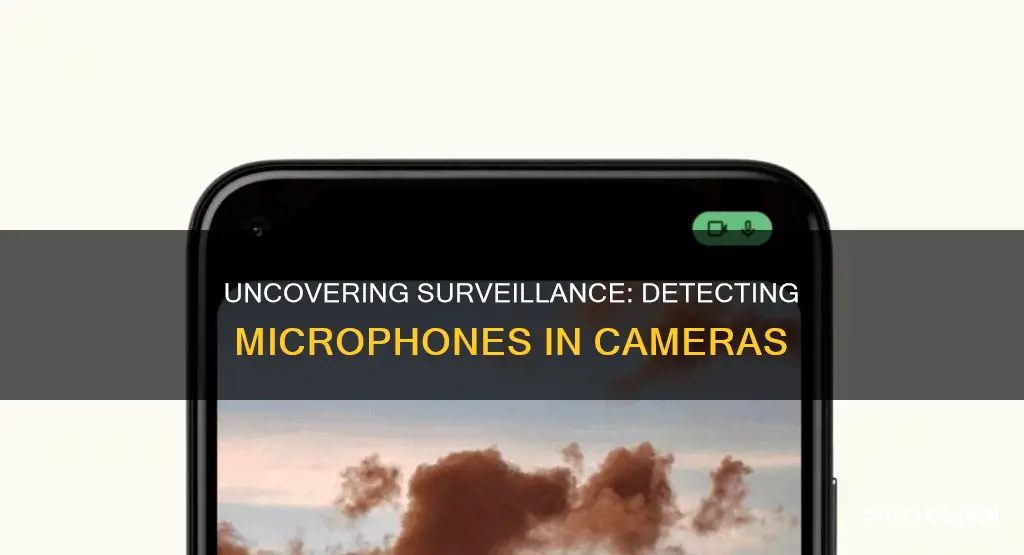
Surveillance cameras are becoming increasingly prevalent in our daily lives, raising concerns about privacy, especially when audio recording is involved. While many security cameras come with audio recording systems, some do not.
- Look for a small hole: Microphones on surveillance cameras usually look like a tiny hole, often smaller than a pinhead. It is typically located on the front of the camera, near the lens.
- Check for external microphones: Some surveillance cameras may have external microphones, which are spherical or box-shaped, measuring a few inches in diameter. They can also resemble a small stick at the end of a wire, taped to the camera.
- Examine the camera's design: IP cameras often share similar designs, with an overt speaker on the back of the device that appears as multiple holes in a circular shape.
- Search online for the camera model: You can look up the camera's model online to find out its specifications, including whether it has audio capabilities.
- Check the camera's serial number: The serial number, usually found on a sticker on the bottom or side of the camera, can indicate whether the camera has audio capabilities.
- Look for external connections: Some cameras may have external cables or connections specifically for audio transfer.
- Play recorded videos: If you have access to the recorded footage, play the videos and listen for any audio.
| Characteristics | Values |
|---|---|
| Speaker | Small and round, usually on the front, back, or side of the camera |
| Microphone | A small single hole, sometimes with the text "reset" next to it |
| External Microphone | A miniature smoke alarm with wires |
| Connections | Ethernet cables, hybrid coaxial cables, or audio-hybrid coaxial cables |
| Camera Type | IP cameras usually have audio, whereas CCTV rarely has audio |
| Camera Age | Cameras five years and older typically do not have microphones |
| Camera Brand and Model | Specific brands and models may be associated with audio capabilities |
| Camera Serial Number | Can be used to search online for audio specifications |
| Camera App | Speaker and mute icons may be present and functional |
| Camera Display Monitor | A small speaker sign may appear next to video recording signs |
What You'll Learn

Check for a single small hole near the lens
If you want to determine whether a surveillance camera has a microphone, one of the most effective methods is to inspect the device for a single small hole near the lens. This hole, which is typically smaller than a pinhead, is a strong indicator of the presence of a microphone.
The placement of the hole can vary, but it is usually located on the front of the camera, close to the lens. In some cases, it may be found on the side or top of the camera housing. If you spot a small hole, take a closer look to see if there is any text printed next to it. If it says 'reset', then it is not the microphone. However, if there is no text, then it is highly likely that the hole serves as the microphone.
It is worth noting that not all cameras with microphones will have this distinct feature. Some cameras may have the microphone located elsewhere, or it may be hidden from view. Additionally, older cameras, typically those that are five years or older, may not have built-in microphones. Therefore, if you do not see a small hole near the lens, it does not necessarily mean that the camera lacks audio capabilities.
To further confirm the presence of a microphone, you can refer to the camera's specifications or serial number, which is usually found on a sticker at the bottom or side of the camera. You can also search for the camera model online or contact the manufacturer directly to inquire about its audio capabilities.
Fight Camera Tickets: Know Your Rights, Texas!
You may want to see also

Look for an overt speaker on the back of the device
If you want to know whether a surveillance camera has a microphone, one of the first things you should do is look for an overt speaker on the back of the device. IP cameras usually have a similar design, so you can expect to find a cluster of holes in a circular shape at the back of the device. While this cluster of holes does not contain the microphone, it is a good indication that the camera has audio capabilities.
The placement of speakers varies, so some are less obvious than others. Be sure to check the underside and top of the device. The microphone is usually not contained within the cluster of holes because it creates audio feedback.
Not all speakers will be as visible and apparent. If you cannot find a cluster of holes, inspect the device for a single small hole. If there is no text printed next to the hole that says "reset", then it is likely the camera's microphone. Microphones are usually found on the front of security cameras, near the lens.
Activating NMS Camera Mode: A Step-by-Step Guide
You may want to see also

Play the recorded video and listen for audio
Playing the recorded video and listening for audio is one of the most effective ways to determine whether a surveillance camera has a microphone. Most security camera manufacturers provide apps that can be installed on mobile devices to view footage. If you have access to these recorded videos, play them and listen for any noise or sound. This way, you can be sure whether the camera has audio capabilities or not.
However, this method has its limitations. For instance, it does not work for cameras installed in public spaces as, in most cases, people do not have access to the video footage. Additionally, the audio quality of security cameras is usually low, especially when the camera is installed outdoors. Background noise from vehicles, planes, or wind can easily overpower the microphone, making it difficult to hear conversations or other relevant audio.
Furthermore, the audio from security cameras is highly compressed to save storage space, which can further reduce the clarity of the sound. As a result, it may be challenging to hear what is being said, especially if the camera is not positioned close enough to the sound source or if there is a significant amount of background noise.
Therefore, while playing the recorded video and listening for audio is a useful method, it may not always provide definitive evidence of a camera's audio capabilities, particularly in outdoor or noisy environments.
Understanding Camera Raw and Its Link to Lightroom
You may want to see also

Search for external microphones
If you're wondering whether a surveillance camera has a microphone, one of the things you can do is to look for external microphones.
External microphones are a common addition to cameras that don't have built-in microphones. They are usually spherical or box-shaped, measuring a few inches in diameter. They can also look like a small stick at the end of a wire, taped to the camera. If you see something that looks like a miniature smoke alarm with wires coming out of it, it's likely an external microphone.
In the past, security cameras only captured video, but now, it's easy to add audio to security cameras using a cheap, small external microphone. If you're in a public space, it's likely that the camera doesn't have native audio support, but it may have hybrid connections that facilitate audio transmission.
If you're looking at a wired analogue system with CCTV cameras and a DVR, it will be easy to spot an external microphone. Just look for a separate small line near the camera. Note that external microphones aren't always placed near the camera; sometimes they are placed near people's seats and have a special connection.
The Evolution of Camera Doorbells: A Comprehensive Guide
You may want to see also

Check the type of cable connections
When it comes to surveillance cameras, cable connections can be a telling sign of audio recording capabilities. Here are some insights on how to check the type of cable connections to determine if a surveillance camera has a microphone:
Coaxial Cables:
Coaxial cables are commonly used with traditional CCTV cameras. These cables are thick and challenging to conceal, often noticeable where they are fed into a wall near the camera. It's important to know that coaxial cables do not support native audio transfer. So, if you see these cables, it's unlikely that audio recording is taking place.
Hybrid Coaxial Cables:
In contrast to standard coaxial cables, hybrid coaxial cables are designed for audio transfer. These cables are used when the camera has no built-in microphone, and audio recording is done separately.
Ethernet Cables:
Ethernet cables, which are thinner and more commonly recognised as the cables used for broadband connections, can be used alongside NVRs (Network Video Recorders). Unlike coaxial cables, Ethernet cables can natively transfer audio. So, if you spot these cables, it's a good indication that audio recording is taking place.
BNC Connectors:
If you have access to the back of the DVR (Digital Video Recorder), you can inspect the BNC connectors for any attached audio devices. Most DVRs have a set of BNC connectors labelled for audio input. If something is connected to these audio connectors, it's likely that audio is being recorded.
RCA Cables:
RCA cables are typically used for audio connections. They are often used to connect microphones to DVRs or cameras. However, RCA cables tend to be short, so longer cable runs may require the use of coaxial cables with BNC connections and an RCA adapter.
In summary, checking the type of cable connections can provide valuable insights into whether a surveillance camera has audio recording capabilities. Coaxial cables without hybrid functionality don't support audio, while Ethernet cables and certain connections on DVRs and cameras indicate the potential for audio recording.
Office Depot's Surveillance Camera Options: What You Need to Know
You may want to see also
Frequently asked questions
Most microphones on surveillance cameras appear as a single small hole, usually near the lens. Some cameras may have a cluster of holes in a circular shape at the back of the device, which is an indication of audio capability.
Conventional surveillance cameras typically lack prominent features like speakers. You can look up the camera's serial number, usually found on a sticker at the bottom of the camera, to determine if it has audio capabilities.
External microphones may be used for audio recording. Look for devices resembling miniature smoke alarms with wires popping out, or check for Ethernet cables connected to the camera, as these can transfer audio.







